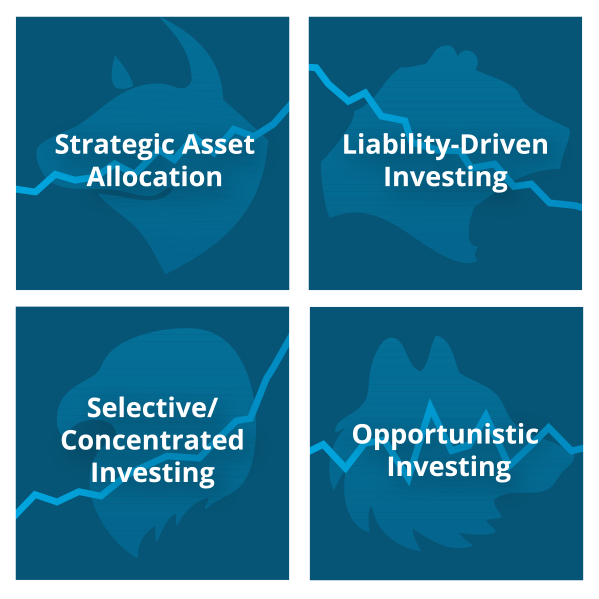

4Thought Financial Group's Unique Investment Methodology
"In order to achieve life goals, one should diversify at the level of investment method, applying the most effective aspects of multiple, completely divergent methods of investing, and not be dogmatic about using a single method"
Learn more about the 4Thought Financial Group Investment Methodology
Since October of 2007, Modern Portfolio Theory has been under attack. One cannot read a single issue of the Financial Times or Wall Street Journal without encountering a statement from a behavioral finance academic, nouveau economist, or tactical portfolio manager proclaiming the death of Modern Portfolio Theory, rationalist economics, diversification, asset allocation, and the Efficient Markets Hypothesis.
A basic tenet of MPT is that a long term risk/return optimal investment portfolio can be created by including “non-correlated” asset classes whose prices have historically moved in opposing or incongruent directions. By including these assets in a portfolio in appropriate percentages, one can generate a portfolio that will reduce the “nonsystematic” risk undertaken (that which is not associated with the market as a whole) in order to generate a certain target rate of return. Alternatively, one could increase the rate of return available at a given level of measured risk. For the last 30+ years, this theory has held up quite well, and in fact nearly all of the world’s major pension fund portfolios and large endowments (the institutional investors) have utilized this methodology in one form or another.
The current criticisms of MPT center around the fact that throughout the world’s current financial crisis and recession, none of the traditional investment asset classes has performed positively, or has even held its value. The vast majority of all asset class prices have dropped precipitously. This statement is irrefutable, and has been taken as evidence that the theory of diversified asset allocation as a risk reducer is defunct. Similarly, in the realm of more general economic theory (as opposed to investment theory), critics have claimed that as a result of an inherent inability of market participants to rationally and accurately assess the risks associated with economic transactions (such as in the subprime mortgage markets and asset-backed securities), that the most basic tenet of classical economics (that economic agents act rationally and are motivated by monetary factors) has also been debunked.
But if these theories are no longer applicable, as critics claim, then what is the alternative explanation for human economic interactions, and how can an investment manager proceed with his/her clients’ assets?
The most popular explanation offered up to answer this question is that it is not the “Theory of rational expectations” that should be followed, but “Behavioral economics”, and it is not “Strategic” asset allocation that should be applied, but “Tactical” asset allocation or some other form of active portfolio trading. Let us first examine the difference between a pure Strategic and pure Tactical asset allocation methodology, and what a blend of these two might look like.
Pure "Strategic" Asset Allocation
Pure strategic asset allocation is that which is most closely associated with the origins of Modern Portfolio Theory. This methodology involves identifying optimal combinations of assets whose historical price movements have had low or negative correlation, and includes them in fixed percentages within a client’s portfolio before selecting a series of securities or managers to fill out the allocation. This is achieved in theory by using a combination of the “risk-free asset” (US Treasuries/T-Bills) and a diversified portfolio of all other available investable assets to attempt to create the “market portfolio”, as described in William Sharpe’s “Capital Asset Pricing Model” and Harry Markowitz’s “Efficient Frontier”. Each asset class or sub-asset-class (Large Cap Value, Small Cap Blend, Short Term Taxable Bonds, Commodities, etc.) is assigned a fixed proportion within the portfolio, which will be adjusted only when the life circumstances or objectives of the client/investor change. Rebalancing back to the original proportions is performed on a regular systematic basis. This systematic method of risk control is meant to eliminate human error from portfolio management.
The overlay manager of such a portfolio would make few or no tactical shifts in the portfolio in response to changes in the economic environment, under the assumption that markets are predominantly efficient, and that tactical portfolio manipulation over the long term will only result in increased transactional costs and economic opportunity costs to the client rather than create returns above what the “market portfolio” can offer. As a result, attempts at “market timing” are shunned, as it is assumed that to properly time buys and sells via intuition or predictive analysis is ineffective on a consistent basis.
Pure "Tactical" Asset Allocation
Pure Tactical asset allocation, at its extreme, is really not asset allocation at all - at least as purists of Modern Portfolio Theory would see it. This is because under Tactical allocation, if an initial allocation is ever outlined in the first place, it will be actively changed and shifted by the overlay portfolio manager in response to predicted changes in the economic environment, specific industry/company expectations, interest rates, etc. Tactical management in its simplest form is neo-classical trading as it occurred in the markets prior to the introduction of Modern Portfolio Theory in the 1960’s.
Tactical management generally places less emphasis on strategic customization of portfolios...
A pure tactical manager may allow him/herself the flexibility to allocate up to 100% of the portfolio to any one asset class or security at a time, or may build a more diverse portfolio if it is suitable at the time. This might, for example, involve shifting a large portion of a portfolio out of its stock components and into its bond and cash components during a market downturn (a very basic tactic that has been prevalent recently). Tactical management generally places less emphasis on strategic customization of portfolios for clients’ long term goals, and more emphasis on acquiring the best available return on assets available in the market at the time.
A Tactical asset manager will generally attempt to purchase securities, investment companies, and other assets that are predicted to produce a return in excess of that available through market averages, or that are not tied to the performance of the market in the event of a downturn. They are generally seeking “absolute return”. Most hedge funds fit into this category, and in some cases, the more traditional speculative stockbroker model fits in this category.
Strategic/Tactical Combo Asset Allocation
Many of those who refer to themselves as “tactical” managers actually apply some of the tenets of the more historically-proven strategic asset allocation methodology of modern portfolio theory. Similarly, many of the self-proclaimed strategic managers will actually take a page from the book of tactical allocators either on an ongoing basis or under certain extreme circumstances. The most historically successful form of combining strategic and tactical allocation has looked something like the following amongst the large institutional-style investors:
The investment manager builds a diversified portfolio of stocks, bonds, cash, commodities, real estate, and other assets based on the individual client’s risk tolerance, time horizon, income/growth/capital preservation/tax efficiency objectives, etc (Strategic). Rebalancing is performed both regularly (Strategic) and opportunistically (Tactical). The manager may attempt to make initial purchases when asset prices are depressed (Tactical) or choose to utilize a dollar cost averaging scheme (Strategic). In addition, while predominantly adhering to the original client asset allocation (Strategic), the manager may make minor shifts of components of the portfolio in order to capitalize on a predicted upcoming investment environment change, which may involve making up to a 5% shift from one asset class/sub-style to another temporarily (Tactical).
Some normally “strategic” managers may also find it necessary to act more tactically in extreme market environments like the one we are currently experiencing in response to client fears and more subjective concerns (ie. “I want to go to cash”).
So Which Is It? Which is Better for Investors?
Extremely strong statistical support for the “Strategic” asset allocation methodology has been documented over the last 30+ years. There is strong historical evidence to support the claim that in terms of long term averages, strategic asset allocation methodologies have outperformed tactical methodologies. Refer to the lifetimes of published work from individuals such as Harry Markowitz, William Sharpe, Eugene Fama, et al for more information on this topic. However, a cacophony of voices in the financial media from a wide variety of critics in the active trading community will say that this evidence has rapidly changed during the current crisis. Tactical asset allocation has in the past generally been considered a higher risk form of investing because of the higher position concentrations that may be associated and the possibility of recurring human error. However, there is some growing evidence to support the stance that over shorter time periods, and especially during extended market downturns, tactical managers will outperform a strategic manager. Refer to more recent research from industry providers such as Genworth Financial Wealth Management for their take on this topic.
So should we simply shift to tactical management when a market downturn occurs? The problem is that it is very difficult to determine when a market downturn will occur and how long it will last, as illustrated by the historical evidence against the likelihood of consistently timing the markets appropriately.
But rather than looking simply at historical averages, let us take a more interdisciplinary approach and think theoretically for a moment.
Pragmatism and Adaptability: The Ultimate Fighting Championship and Investment Management
Consider the following analogy: The Ultimate Fighting Championship was a no-holds-barred hand-to-hand combat competition that took root in the early 1990’s in the United States. At the outset, this competition was billed as a no-rules fight between willing professional fighter participants from all specialty areas of fighting, including the traditional martial arts, boxing, wrestling, kickboxing, submission grappling, military hand-to-hand combat, etc. The only rules were no biting, no eye-gouging, and no “fish-hooking”. Wins occurred by knockout, submission, or referee stoppage only.
Each fighter proclaimed his own fighting art or specialty, and the tournaments were initially seen as style-vs.-style competitions to see which art was most effective in a “reality” scenario, when there were no rules. After decades of the dominance of boxing and karate being seen by the public as the most effective fighting arts due to familiarity with the styles, it was taken as granted that these styles would dominate. It soon became stunningly clear that this sentiment was unfounded.
Indeed, it was the grapplers, wrestlers, and jiu-jitsu stylists that seemed to be winning all of the matches. As such, a revolution occurred, in which grappling, as opposed to striking, was seen as the new dominant force. This dominance continued for nearly ten years. This is analogous to the advent of Modern Portfolio Theory in the 1960’s. Then something happened.
A new type of fighter began to emerge that had become highly skilled in both the striking and grappling arts, utilizing the best of both philosophies to enable both superior strategy versus his competition, and superior tactical application. When faced with an opponent that held superior grappling skills, he was able to defend against the attacks with his own grappling skill and to take the specialist grappler off his game using his own striking skills. Similarly, when faced with a superior striker opponent, he was able to defend against the strikes with his knowledge of that methodology, but was also able to counter and submit his striker opponent using grappling skills. To date, these eclectic, pragmatic, adaptable fighters continue to dominate the Ultimate Fighting Championship and other Mixed Martial Arts competitions.
The analogy here is that evolving paradigms occur not just in martial arts competitions, but also in our real world of economics and investment management. Those that utilize not just one philosophy or another, but the best of all philosophies, are most likely to survive and thrive in an unforgiving environment. Similar trends can be found in evolutionary biology. In the fossil record, those species that have physical and behavioral adaptations suitable for multiple circumstances and environments seem to have survived for eons, while those extreme specialists that thrive in the good times but are unable to adapt to changing environments generally go extinct. This is a concept that can be found throughout nature, throughout the sciences, and throughout mathematics. It seemingly now applies to economics and investment management as well.
If we follow this analogy to its logical conclusion, nature and the universe are telling us something: We must diversify and adapt. For us, that means applying MULTI-PHILOSOPHY INVESTING. The question is not whether to apply a Strategic, Tactical, or Combination investment philosophy, but when, how much, and for whom each of them should be applied. Also, we should ask whether there are ways to improve upon the existing philosophies to create something better for our clients. 4Thought believes there are. In upcoming issues of the Compass & Crosshairs, we will be exploring the avenues by which this can occur.







Leave a Comment